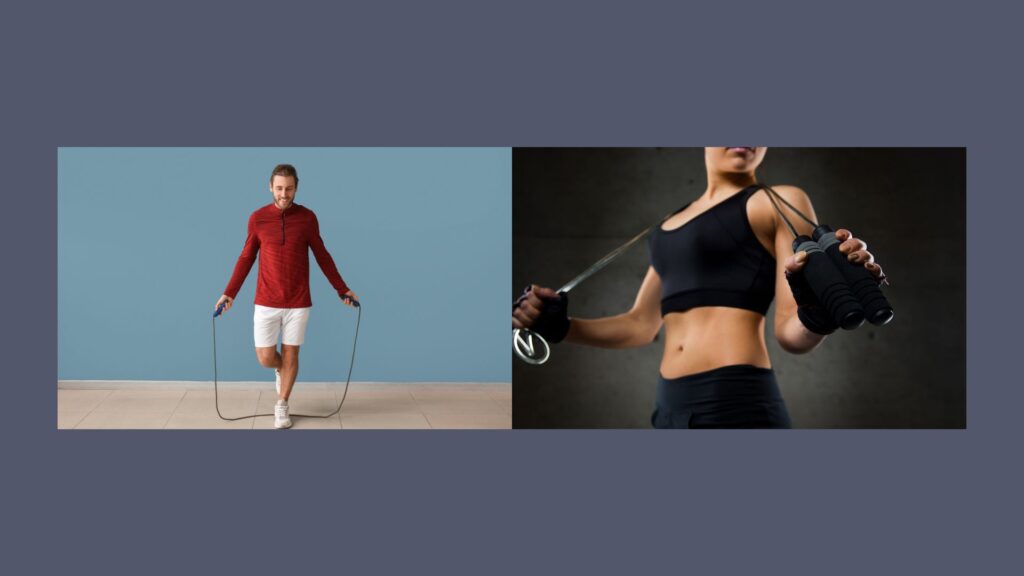Weighted jump rope muscles worked to include an extensive meeting of major muscle groups, from calves to shoulders. This flexible workout tool not only improves heart-lung fitness but also increases strength and stability. By including weighted jump ropes in your routine, you target core balance, arm power, and lower body muscles effectively.
Introduction:
Jump ropes can help you gain muscle as well as improve your heart and lungs. Elevate the situation using weighted jump ropes. Working multiple muscles at once, they blend strength training with cardio. If you’re not sure if weighted jump ropes are for you, we’ll go over the drawbacks and advantages of utilizing them.
Understanding Weighted Jump Rope:
Weighted jump ropes are expertly designed to add resistance to the regular jump rope workout. Usually, these ropes feature handles with joined weights, which can vary in mass based on individual preferences and fitness levels. The added resistance boosts the workout, resulting in greater exertion from the muscles engaged,and amplifying the benefits reaped from each session.

Boost Your Home Workout With a Weighted Jump Rope
I am able to assist! Using a weighted jump rope might help you increase the intensity of your at-home workouts. Compared to a standard jump rope, it burns more calories and develops muscle more quickly.
What is a Weighted Jump Rope?
A weighted jump rope is like a regular jump rope, but with added weights in the handles or built into the rope. It’s basically jump rope on hard mode!
- Easier Than a Speed Rope/Regular Jumpe Rope
- Burn Calories and Build Muscle
- Shoulder Strength and Mobility
- Additional Muscles Engaged
- Posture
- Variety
- Fun
Muscles worked weighted jump rope:
- Engages lower body muscles such as the quad, calves, and glutes during each jump, providing strength and power progress.
- Activates core muscles, Weighted jump rope muscles worked including viscera and obliques, to stabilize the body and maintain proper posture throughout the exercise.
- Selects upper body muscles such as the trigonal and forearms, increasing shoulder strength and grip stability with the swinging motion of the rope.
- Promotes heart-lung health by boosting heart rate and improving lung function through regular breathing patterns.
- Provides an extensive full-body workout, offering a versatile training option for increasing muscular stability, coordination, and agility.
You’re on the right track! Knowing muscles worked by exercises is a good fitness sign.For a full-body workout, weighted jump ropes are fantastic.
- Shoulders
- Back
- Arms
- Core
- Glutes
- Quads and Calves
What muscles do weighted jump ropes work?
Weighted jump ropes successfully select many muscle groups, including the lower body muscles such as the quads, calves, and glutes, which power the body during each jump. Plus, the core muscles, including the viscera and obliques, play a key role in stabilizing the body and maintaining proper posture.
Upper body muscles like the deltoids and forearms are engaged as the rope is swung, contributing to shoulder power and grip endurance. This extensive workout not only increases muscular strength and endurance but also promotes heart-lung health through increased heart rate and improved lung function.
WEIGHTED JUMP ROPE BENEFITS:
- Increases heart-lung fitness: Weighted jump rope workouts elevate heart rate and improve lung function, leading to improved heart-lung health and stability.
- Increased calorie burn: Adding resistance to jump rope exercises increases intensity, Weighted jump rope muscles worked resulting in greater calorie spending, making it an effective tool for weight loss and management.
- Improved muscular power and stability: engages multiple muscle groups, including the lower body, core, and upper body, leading to increased strength, endurance, and overall muscle tone.
- Enhanced coordination and agility: Jumping rope, especially with added weight, requires precise coordination and timing, improving overall agility and motor skills.
- Convenience and versatility: weighted jump ropes are portable and require minimal space, making them accessible for workouts anywhere, anytime, and can be easily incorporated into various training regimens for a well-rounded fitness routine.
Can you jump rope with a weighted vest?
Yes, jumping rope with a weighted vest is possible and can boost the workout by adding resistance to the exercise. This combination challenges muscles further, increases power, and increases calorie burn. Weighted jump rope muscles worked However, it’s necessary to start with lighter weights and usually increase intensity to avoid strain or injury.

Weighted jump rope muscles worked:
Weighted jump ropes engage a variety of muscles, including the quadriceps, calves, core, deltoids, and forearms, providing a comprehensive full-body workout. The added resistance amplifies muscle activation, promoting strength, endurance, and coordination.
Muscle groups worked on a weighted jump rope:
Weighted jump ropes catch muscles across the body, from the quadriceps and calves to the core and shoulders, encouraging power and stability.
- Quadriceps
- Calves
- Core (Abdominals and Obliques)
- Deltoids
- Forearms
Do weighted jump ropes build muscle?
- Resistance Training: Weighted jump ropes add resistance, requiring muscles to work harder during each jump, thus promoting muscle growth.
- Engages Upper Body: Unlike regular jump ropes, weighted ones engage the upper body more intensely, especially the shoulders, arms, and back muscles, contributing to muscle development.
- Core Activation: The added weight request increased core balance to maintain balance and cooperation, leading to bracing abdominal muscles and obliques.
- Variable Intensity: Adjusting the intensity of jumps with weighted ropes challenges muscles differently, allowing for growing overload and muscle change over time.
- Compound Movement: Jumping with weighted ropes involves multiple muscle groups working together, offering a full-body workout that can contribute to overall muscle development and toning.
How long should you use a weighted jump rope?
The period of using a weighted jump rope depends on individual fitness goals and physical condition. Beginners may start with shorter sessions, slowly increasing the duration as energy improves. A general guideline suggests 10-30 minutes per session, 3-5 times a week, to reap benefits while allowing for adequate recovery and muscle growth.
What is the purpose of a weighted skipping rope?
A weighted skipping rope serves to increase workouts by adding resistance, boosting muscle engagement, and promoting power and stability development. It dares users to exert more force, Weighted jump rope muscles worked, resulting in improved heart-lung fitness, cooperation, and overall sports performance. Its creativity caters to individuals seeking diverse, effective exercise routines for extensive physical conditioning.

Does weighted jump rope work abs?
Weighted jump ropes effectively engage the abdominal muscles, as they require increased core stabilization to maintain balance and coordination during jumps. The added resistance intensifies the workout, leading to greater muscle activation in the abs, contributing to improved strength, definition, and overall core stability over time.
Weighted jump rope muscles worked for weight loss
Weighted jump ropes offer an active twist to regular jump rope exercises, and raise muscle engagement and calorie burn. Include them into workouts selects many muscle groups including calves, Weighted jump rope muscles worked shoulders, arms, and core. This extensive approach not only aids in weight loss but also increases heart-lung health and overall stability, making it a potent tool in fitness regimes.
Heavy jump rope workout for beginners:
- Begin with a suitable weight: Start with a heavy jump rope that challenges you but allows for proper form and control.
- Focus on technique: Organize mastering the basic jump rope methods before moving to more complex moves.
- Incorporate intervals: Other between periods of intense jumping and rest to build energy slowly.
- Features proper posture: Maintain an upright posture with shoulders relaxed and core engaged to prevent strain.
- Gradually increase intensity: As you gain confidence and power, usually increase the periods and intensity of your heavy jump rope workouts.
Weighted jump rope before and after:
Before:
- Warm-up thoroughly: Prepare your body for the workout with dynamic extend and light cardio to prevent injuries.
- Choose the right rope: Select a weighted jump rope that suits your fitness level and goals, ensuring it’s comfortable to handle.
- Set realistic goals: Establish achievable objectives such as duration or number of jumps to track progress effectively.
- Focus on technique: Prioritise proper form to maximize muscle engagement and minimize Weighted jump rope muscles worked strain on joints.
- Stay hydrated: Drink water before and during your workout to maintain optimal performance and prevent dehydration.
After:
- Cool down: End your workout with static stretches to improve flexibility and aid muscle recovery.
- Reflect on progress: Take note of any improvements in stability, speed, or methods to stay motivated.
- Hydrate and refuel: Replenish fluids and consume a balanced meal or snack containing protein and carbohydrates to support muscle repair.
- Assess fatigue and recovery: Listen to your body’s signals and adjust your training intensity or schedule accordingly.
- Plan for rest: Allow adequate time for rest and recovery between jump rope sessions to prevent overtraining and promote muscle growth.

Conclusion:
Weighted jump ropes represent a blend of cardio and resistance training, offering a mixed approach to fitness increses. By selecting a wide range of muscle groups and providing many health benefits, they have earned their place as a staple in the fitness arsenal of individuals worldwide.
Whether you’re aiming to improve heart-lung health, build muscular power, Weighted jump rope muscles worked, or increases overall agility, the weighted jump rope stands ready to propel you towards your fitness goals. So, grab your rope, add some weight, and jump into a world of endless chance for a fitter, stronger, and healthier you.
FAQS:
Which specific muscle groups are primarily targeted when using a weighted jump rope during exercise sessions?
Weighted jump ropes primarily engage the core muscles, Weighted jump rope muscles worked including abdominals and obliques, along with shoulders, arms, and calves, providing a comprehensive full-body workout experience.
How does the incorporation of weighted jump rope routines affect muscle engagement compared to traditional jump roping?
Compared to standard jump roping, weighted jump ropes intensify muscle engagement, particularly in the upper body and core, due to the added resistance, enhancing strength and endurance.
Can you explain the significance of targeting these particular muscles through weighted jump rope workouts for overall fitness and strength development?
Selecting these muscles through weighted jump rope workouts not only improves cardiovascular fitness but also enhances muscular strength, endurance, and coordination, contributing to overall physical health and athletic performance.
